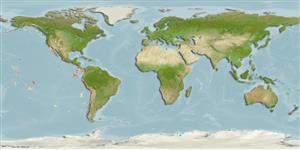Holocephali (quimeras) (chimaeras) >
Chimaeriformes (Chimaeras) >
Chimaeridae (Shortnose chimaeras or ratfishes)
Etymology: Hydrolagus: hydro-, combining form of hydor (Gr.), water; lagos (Gr.), hare, i.e., “water rabbit,” probably referring to three pairs of tooth plates, which tend to protrude from the mouth like a rabbit’s incisors. (See ETYFish); macrophthalmus: macro-, from makros (Gr.), long; ophthalmos (Gr.), eye, referring to its large oval eyes. (See ETYFish).
Environment: milieu / climate zone / depth range / distribution range
Ecologia
marinhas batidemersal; intervalo de profundidade 590 - 1160 m (Ref. 97389). Subtropical
Eastern Pacific: from the central coast of Mexico, Costa Rica, Peru and Chile.
Tamanho / Peso / Idade
Maturity: Lm ? range ? - ? cm
Max length : 63.9 cm TL macho/indeterminado; (Ref. 97389); 58.1 cm TL (female)
Descrição breve
Morfologia | Morfometria
This species is distinguished by the following set of characters: slender body; short and bluntly rounded snout; relatively short head (HDL 24.2-24.5% BDL); relatively large eyes (EYL 30.9-34.2% HDL); oral and preopercular lateral line canals sharing a short common branch from the infraorbital canal; relatively large pectoral fins (P1A 36.5-40.8% BDL), extending posterior to the insertion of pelvic fins; trunk's lateral line canal without sinusoidal undulations; the anterior and posterior regions of second dorsal fin considerably taller than middle region; no anal fin; tail region elongate and slender (PCA 58.3-59.9% BDL); caudal-fin axis horizontal with the fin nearly symmetrical, epaxial and hypaxial lobes equal sized; coloration uniform brown across entire body, no white markings and bluish fins (Ref. 97389).
Oviparous (Ref. 205). Eggs are encased in horny shells (Ref. 205).
Life cycle and mating behavior
Maturidade | Reprodução | Desova | Ovos | Fecundidade | Larvas
Angulo, A., M.I. López, W.A. Bussing and A. Murase, 2014. Records of chimaeroid fishes (Holocephali: Chimaeriformes) from the Pacific coast of Costa Rica, with the description of a new species of Chimera (Chimaeridae) from the eastern Pacific Ocean. Zootaxa 3861(6):554-574. (Ref. 97389)
Categoria na Lista Vermelha da IUCN (Ref. 130435)
Ameaça para o homem
Harmless
Utilização humana
Mais informação
Idade/TamanhoCrescimentoComprimento-pesoComprimento-comprimentoFrequência de comprimentoMorfometriaMorfologiaLarvasDinâmica larvarRecrutamentoAbundânciaBRUVS
ReferênciasAquaculturaPerfil para aquaculturaEstirpesGenéticaElectrophoresesHereditariedadeDoençasProcessamentoNutrientsMass conversion
ColaboradoresFotografiasStamps, Coins Misc.SonsCiguateraVelocidadeTipo de nataçãoÁrea branquialOutras referênciasCérebrosVisão
Ferramentas
Relatórios especiais
Descarregue XML
Fontes da internet
Estimates based on models
Phylogenetic diversity index (Ref.
82804): PD
50 = 0.5000 [Uniqueness, from 0.5 = low to 2.0 = high].
Bayesian length-weight: a=0.00282 (0.00118 - 0.00673), b=3.10 (2.89 - 3.31), in cm total length, based on LWR estimates for this (Sub)family-body shape (Ref.
93245).
Nível Trófico (Ref.
69278): 3.8 ±0.6 se; based on size and trophs of closest relatives
Resiliência (Ref.
120179): Baixo, tempo mínimo de duplicação da população 4,5 - 14 anos (Assuming Fec <100).
Fishing Vulnerability (Ref.
59153): Moderate to high vulnerability (46 of 100).
Nutrients (Ref.
124155): Calcium = 38.6 [9.8, 112.6] mg/100g; Iron = 0.933 [0.321, 3.831] mg/100g; Protein = 16.9 [11.3, 20.1] %; Omega3 = 0.325 [0.136, 0.762] g/100g; Selenium = 40.6 [8.9, 111.7] μg/100g; VitaminA = 8.59 [2.78, 25.30] μg/100g; Zinc = 0.599 [0.309, 1.157] mg/100g (wet weight);
